Related Research Articles

A brigade is a major tactical military formation that is typically composed of three to six battalions plus supporting elements. It is roughly equivalent to an enlarged or reinforced regiment. Two or more brigades may constitute a division.
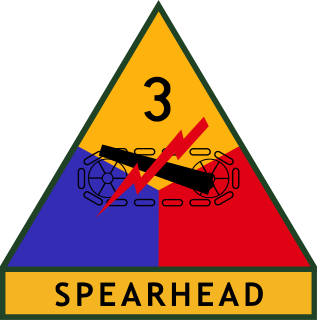
The 3rd Armored Division ("Spearhead") was an armored division of the United States Army. Unofficially nicknamed the "Third Herd," the division was first activated in 1941, and was active in the European Theater of World War II. The division was stationed in West Germany for much of the Cold War, and participated in the Persian Gulf War. On 17 January 1992, in Germany, the division ceased operations. In October 1992 it was formally inactivated as part of a general drawing down of forces at the end of the Cold War.

The Italian Army is the land-based component of the Italian Armed Forces of the Italian Republic. The army's history dates back to the unification of Italy in the 1850s and 1860s. The army fought in colonial engagements in China, Libya, Northern Italy against the Austro-Hungarian Empire during World War I, Abyssinia before World War II and in World War II in Albania, Balkans, North Africa, USSR and Italy itself. During the Cold War, the army prepared itself to defend against a Warsaw Pact invasion from the east. Since the end of the Cold War, the army has seen extensive peacekeeping service and combat in Afghanistan and Iraq. Its best-known combat vehicles are the Dardo infantry fighting vehicle, the Centauro tank destroyer and the Ariete tank and among its aircraft the Mangusta attack helicopter, recently deployed in UN missions. The headquarters of the Army General Staff are located in Rome opposite the Quirinal Palace, where the president of Italy resides. The army is an all-volunteer force of active-duty personnel.

The 37th Armor is an armor (tank) regiment of the United States Army. It is often remembered as the successor to the 37th Tank Battalion, 4th Armored Division, commanded by then Lieutenant Colonel Creighton Abrams during World War II.
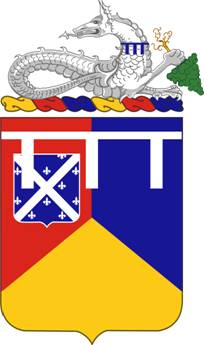
The 66th Armor Regiment is the oldest armored unit in the United States Army, tracing its lineage to the 301st Tank Battalion which served with distinction soon after it was formed in the First World War; the 301st trained at Camp Meade, MD, where then Cpt. Dwight D. Eisenhower was an instructor. It has often been rumored that the 301st, the parent unit of the 66th, was first commanded by Col. George S. Patton, but this appears not to have been the case; while Patton was the first officer assigned to the Tank Corps, and while the 301st Tank Battalion was the first unit formed, Patton went nearly immediately to France to train Americans attached to Allied commands. The 301st was the only American heavy tank battalion to have seen action in the war. After the war, the 301st transitioned in the Regular Army to become the 66th Infantry Regiment by way of the 16th Tank Battalion.

The tank destroyer battalion was a type of military unit used by the United States Army during World War II. The unit was organized in one of two different forms—a towed battalion equipped with anti-tank guns, or a mechanized battalion equipped with armored self-propelled guns. The tank destroyer units were formed in response to the German use of massed formations of armored vehicles units early in WWII. The tank destroyer concept envisioned the battalions acting as independent units that would respond at high speed to large enemy tank attacks. In this role, they would be attached in groups or brigades to corps or armies. In practice, they were usually individually attached to infantry divisions. Over one hundred battalions were formed, of which more than half saw combat service. The force was disbanded shortly after the end of the war when the concept had been shown to be militarily unsound.
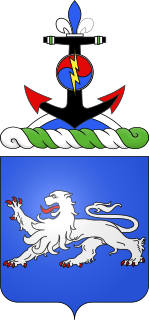
The 68th Armor Regiment was first activated in 1933 in the Regular Army as the 68th Infantry Regiment.
The 77th Armor is an armored (tank) regiment of the United States Army. The 77th Armor Regiment is part of the U.S. Army Regimental System with only a single battalion, the 1st Battalion, 77th Armor Regiment, and is therefore classified as both a single battalion and the remainder of the Regiment itself. 1–77 AR is currently stationed at Fort Bliss, Texas as part of the 3rd Brigade "Bulldogs", 1st Armored Division and has transformed from a tank pure battalion into a combined arms battalion (CAB).
The 70th Armor Regiment is an armored (tank) unit of the United States Army. It was constituted as the 70th Tank Battalion in July 1940, an independent tank battalion intended to provide close support to infantry units. In this role, it saw action in the Mediterranean and European Theater of Operations, making assault landings and fighting with the 9th Infantry Division in North Africa, and with the 1st Infantry Division in Sicily. The battalion supported the 4th Infantry Division on Utah Beach during the D-Day landings in France, and fought with the 4th Infantry Division through the remainder of World War II. The 70th Tank Battalion was one of the first three tank battalions to deploy to Korea in the Korean War, where it saw significant action, primarily with the 1st Cavalry Division.
The U.S. 41st Infantry Regiment is a regiment of the United States Army. Its 1st Battalion is currently assigned to the 2nd Infantry Brigade Combat Team, 4th Infantry Division. Its 3rd Battalion is assigned to the 1st Stryker Brigade Combat Team, 1st Armored Division.
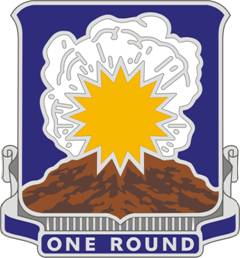
The 705th Tank Destroyer Battalion was a tank destroyer battalion of the United States Army active during the Second World War. It was originally formed from artillery elements of the 5th Armored Division, and its lineage is today perpetuated by the 75th Cavalry Regiment.

Storck Barracks/Illesheim Kaserne is a United States Army facility adjacent to Illesheim, Germany, located about 15 miles northwest of Ansbach (Bavaria), about 240 miles south-southwest of Berlin.

This article on military tanks deals with the history and development of American tanks: their origin during World War I; the interwar period; World War II; the Cold War; and the modern era.
The 67th Armored Regiment is an armored regiment in the United States Army first formed in 1929 in the Regular Army as the 67th Infantry Regiment. It first became the 67th Armor in 1940. The regiment participated in World War I, World War II, Desert Storm/Desert Shield, Operation Iraqi Freedom, Operation Enduring Freedom, Operation Spartan Shield, Operation Inherent Resolve, Operation Resolute Support, and Operation Freedom's Sentinel.

The 103rd Armor Regiment is an armored regiment in the Pennsylvania National Guard first formed in 1941. Its legacy unit, 3rd Battalion, 103rd Armor, is a subordinate command of the 55th Heavy Brigade Combat Team, 28th Infantry Division.
The 827th Tank Destroyer Battalion was a tank destroyer battalion of the United States Army active during the Second World War. It was activated in April 1942 as a segregated African American unit, deploying to Europe at the end of 1944 and attached to 12th Armored Division. It saw action during Operation Nordwind in January 1945, where elements of the battalion performed creditably. However, its overall combat record was marred by severe disciplinary problems and insufficient training. It was withdrawn in February, and assigned to rear-area duties; while it nominally remained active for the remainder of the war, it had been effectively disbanded.

The 69th Armor is an armored (tank) regiment of the United States Army. The 69th Armor Regiment is part of the U.S. Army Regimental System with only two battalions, the 2nd and 3rd Battalion, 69th Armor Regiment, existing in separate brigades and representing the regiment as a whole. 2–69 AR is currently stationed at Fort Stewart, Georgia as part of the 2nd Armor Brigade Combat Team ("Spartans"), 3rd Infantry Division and 3–69 AR is stationed at Fort Stewart, Georgia as part of the 1st Armor Brigade Combat Team ("Raider"), 3rd Infantry Division. Both battalions have transformed from tank pure battalions into combined arms battalions (CAB), Each comprising two tank companies and one mechanized infantry company as of August 2019.
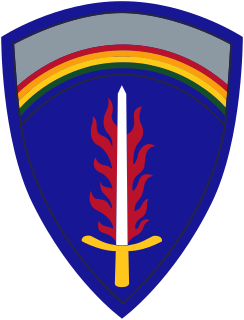
United States Army Europe (USAREUR) is an Army Service Component Command (ASCC)/Theater Army responsible for directing United States Army operations throughout the U.S. European Command (EUCOM) Area of Responsibility (AOR). During the Cold War, it supervised ground formations primarily focused upon the Warsaw Pact to the east as part of the North Atlantic Treaty Organisation's (NATO) Central Army Group (CENTAG). Since 1989, it has greatly reduced its size, dispatched U.S. forces to Southwest Asia, Kosovo, the War on Terrorism and increased security cooperation with other NATO land forces.

The 40th Armor Regiment was an armored regiment of the United States Army until the inactivation of its last element, its 1st Battalion, in 1997. It was redesignated and reactivated in 2005 as the 40th Cavalry Regiment and assigned to the 4th Brigade Combat Team (Airborne), 25th Infantry Division.

Separate tank battalions were military formations used by the United States Army during World War II, especially in the European Theater of Operations. These battalions were temporarily attached to infantry, armored, or airborne divisions according to need, though at least one battalion spent the entire war in Europe attached to one division. They were also known as general headquarters ("GHQ") tank battalions.
References
- ↑ Lee, Ulysses. The Employment of Negro Troops. Washington, DC: U.S. Army Center of Military History, 2001. p. 121.